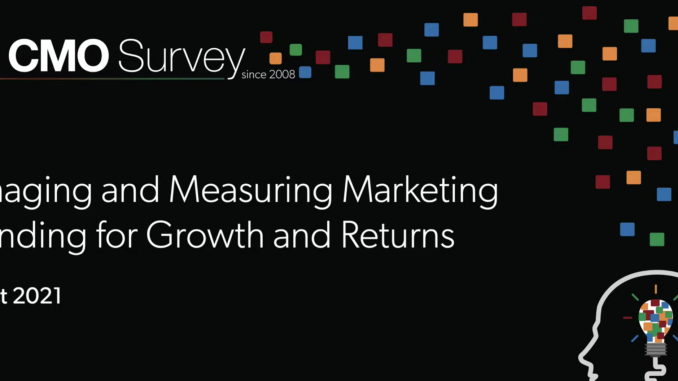
Results from the 27th edition of The CMO Survey show that marketer responsibilities and strategic roles have increased against rise in digital spending
Digital marketing spending has grown to comprise 58% of marketing budgets, reflecting 15.8% growth over the last year, and is projected to grow by 14.7% in the next year. In the wake of this spending, the 27th edition of The CMO Survey finds that digital marketing is the No. 1 responsibility reported by marketers, superseding a dominant historic focus on brand-related activities. These and other results are based on a sample of 282 top marketers at for-profit U.S. companies, 94.1% of whom are VP-level or higher.
The pandemic has prompted many companies to undergo a rapid transformation in their go-to-market models. More companies report moving past the nascent phase of their digital transformations (31.1% in this phase a year ago to only 8.6% today) and into emerging (53.1%), integrated (26.9%) or institutionalized (11.4%) phases. Marketing leaders report being asked to lead 73% of the digital transformation in companies, challenging assumptions that such processes are managed primarily by technology leaders.
Marketing leaders are also asked by their CEOs or CFOs to participate in board meetings (at a rating of 4.9) and in the preparation for earnings calls (at a rating of 3.6 on a 7-point scale where 1=never and 7=all the time) more than ever. Although there is room for improvement, these encouraging results indicate marketing leaders are earning a seat at the table more than is suggested in the popular press.
As CMOs earn opportunities to spotlight the role of marketing with key stakeholders, they face increasing pressure to signify the value of their marketing efforts, with 59% of marketing leaders reporting increased pressure from CEOs and 45% reporting increased pressure from CFOs. Most marketers report that they are able to show the short-term impact of marketing spend using quantitative tools, while the majority report that showing the long-term impact remains more of a qualitative assessment.
Considering the specific metrics used, marketing leaders report that sales impact and customer engagement make up almost 50% of the evaluation. Consistent with this finding, sales revenue and digital performance are the most consistently tracked marketing outcomes. Metrics such as brand equity value and customer lifetime value, on the other hand, are rarely tracked. Marketers expect the use of artificial intelligence or machine learning for prediction and measurement to triple over the next three years.
Overall marketing spending increased by 5.2% over the last year and is expected to grow next year by 13.4%. Traditional advertising spending projections increased for the first time in a decade with expected growth at 1.4% for the next year. Marketing expenses as a percentage of company revenue declined for the first time since 2017, but climbed as a percentage of company budget. Given the growth in overall marketing budgets in the past year, evidence suggests that revenue climbed more during the same time frame, driving down marketing expenses as a percentage of company revenue.
Marketers’ optimism for the U.S. economy rebounded beyond mid-pandemic levels and started to stabilize around pre-pandemic values. Optimism hit 69.6 (out of 100), up from 66.3 in February 2021 and up dramatically from 50.9 at the height of COVID in June 2020. Consistent with this, marketers report large increases in revenue gains (11.1%) and profits (10.4%) following only 0.3% revenue gains and 2.6% profit gains in February 2021. The Delta variant has tempered optimism for the next quarter, but, overall, marketers report a more optimistic outlook for their largest revenue markets.
Considering human capital issues, companies report an average increase of 10.6% of marketing spend on diversity, equity and inclusion (DEI) in the past year, up from 8.9% just six months ago. Against that spending, marketers report more changes to the DEI of marketing training, segmentation/targeting, product/service design, and partnerships. At the same time, companies are making minimal changes to their marketing strategies to reach more diverse customers. In fact, almost a quarter of companies are not changing their marketing strategies at all, citing difficulty envisioning and assessing the value of DE&I-related opportunities as the top barriers.
When asked about how post-pandemic work-from-home opportunities are impacting their marketing organizations, marketing leaders report more opportunity to hire people who want to work-from-home (74%) than to lose (33%) these workers. Likewise, marketing leaders report more opportunity to hire people who want to work-from-office (62%) than lose (12%) these workers.
Complete results of the 27th edition of The CMO Survey, including detailed marketing and performance trends across industries, can be found at cmosurvey.org/results.
Sign up for the My AMA Daily newsletter
Our brand-new daily email combines original thought leadership content from the AMA with the best resources and news from around the web.

Leave a Reply